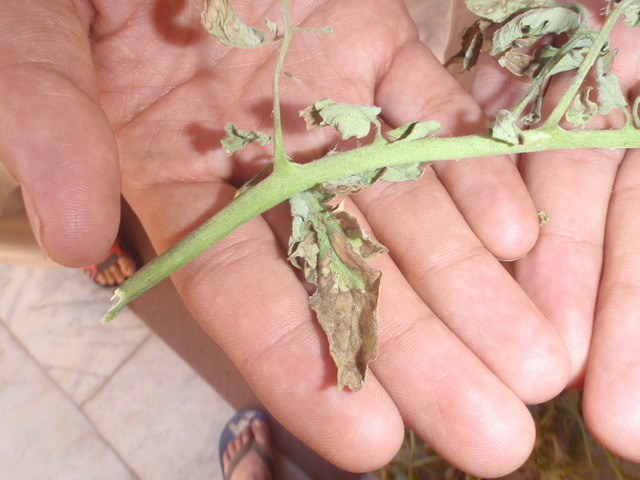Summer rains, humidity exacerbate plant diseases
There has been a major shift in the potential health of garden and landscape plants during the past two weeks. Yes, it has been hot but most plants can handle that kind of heat. This shift is less obvious.
Arizona knows it as its “summer monsoon.” We notice a buildup of clouds, usually in the afternoon, with occasional light precipitation. Less obvious is a concurrent jump in humidity.
We might notice the jump in relative humidity because the heat is more uncomfortable than normal or our sweat does not evaporate as quickly. A combination of high temperatures and increased humidity causes disease problems that would not normally occur if just high temperatures were present.
The worst plant health situation is when light summer rainfalls occur at sunset or early in the evening. Most disease problems need several hours to “incubate” undisturbed. Incubation of diseases during nighttime, when the sun is not drying things out, gives us the most problems.
Expect to see disease problems in lawns, vegetables such as tomatoes, grapevines and other plants with dense foliage. If it is possible, thin out the foliage for better air movement through the plant. Pinch or cut off leaves to encourage air movement through dense plants. Remove leaves that are close or touching the soil that can harbor diseases or insects.
If diseases have been problems in the past at this time of the year, you might consider applying a fungicide as a preventive. This is particularly true with lawns that had disease problems in the past.
Apply a preventive fungicide after a rain event or irrigation. Always follow label directions.
Q: New growth on my African sumac has curled leaves and it looks like aphids or something is attacking them. I thought sumacs were desert trees and didn’t a have a lot of issues so I’m surprised by this development.
A: African sumac does get aphid problems. Aphids are more of a problem during cool weather and the problem usually disappears with the heat. But aphids will hang around during the heat and cause problems as well. A good indicator of aphids is the presence of ants.
If the aphid problem is bad enough you may see leaf yellowing and leaf drop, sticky or glossy leaf surfaces. The stickiness is aphid excrement that is sugary and attracts the ants.
Soap and water sprays will get them under control if applied every few days. Soapy sprays do not hang around long.
Or you can use a systemic insecticide applied to the soil around the base of the tree and watered in. The poison moves up the tree to the leaves and poisons the aphids.
This may be safer to use and more environmentally friendly than spraying the entire tree with a pesticide.
Remember that African sumac is a messy tree with lots of leaf drop. If you don’t want a mess, you might not want African sumac.
Q: I bought an ocotillo two years ago and it has yet to turn green and become alive. Should I get a new one? I do not know how to move forward on this.
A: It may have been dead when you bought it or it may have died after you planted it. Yes, replace it. Two years is long enough to wait. I provided some documents to help get you off to a better start with your ocotillo:
■ http://www.dbg.org/system/files/55/original/Planting%20Ocotillo.pdf?1279065377
■ http://www.tucsoncactus.org/pdf_files/TCSS_Ocotillo_Planting.pdf
■ http://www.starnursery.com/media/SN_Tips/SN415_Ocotillo-Care.pdf
Q: I have an older olive tree that is messy. Is there a way to prevent it from blooming in the spring and dropping all its yellow flowers? It also sheds a lot of leaves not only during the spring but year-round. Is there any way to prevent that also?
A: The only consistent way to eliminate or reduce flowering is to spray an olive tree with an appropriate chemical before it blooms. In the past, the most effective timing has been in mid to late February or March using a chemical called Maintain. It needs to be applied by a commercial applicator.
Commercial applicators have access to other chemicals as well but they usually are not as effective as Maintain. The less effective chemicals are sprayed at the time the olive tree is blooming. These are primarily aimed at fruit elimination, not flower elimination.
These other chemicals cause the flowers to abort after they are open. It should be obvious if the chemical has to be applied when the flowers are open, it will not do much to eliminate flowers or reduce the release of pollen.
This is an important question to ask a commercial applicator: When does your chemical need to be applied? If the response is during bloom, then this is not the right chemical to use to eliminate flowers.
There are two different products available to homeowners that might be useful to some as a spray. One is fairly effective at eliminating flowers. The other does not do much to the flowers but is fairly good at eliminating fruit.
When you go to your favorite nursery or garden center, look for sprays that eliminate fruit from trees. Read the label. If the label says it must be sprayed when the flowers are open, it will not be effective as a “flower eliminator.”
The other spray has a label that tells you to apply it just before the flowers are open. This spray has a much better chance of eliminating the flowers. Again, read the label.
Regarding leaf drop, olive is evergreen so some shedding is normal since it drops leaves primarily as it puts on new growth. But some leaf drop will occur season-long.
Excessive leaf drop is not normal. The primary reason for excessive leaf drop throughout the canopy would be lack of enough water. When there is not enough water, then it is normal for a plant to drop leaves to reduce its need for water.
Make sure your water sources are not plugged, restricted or the clock has not been changed for some reason. Make sure olive trees received enough water during irrigation. You might have to add emitters.
If the leaf drop is coming from only one or two branches, this is also not normal and could be a sign of disease and you will need to investigate this further.
Q: I purchased a Pink Lady apple tree in the fall. It is doing well. What besides a crabapple tree is a suitable pollinator for this tree? I have been getting different opinions on this.
A: You don’t need a pollinator for that tree. It is self-pollinating in our climate. For the best information on which trees need pollinators you should visit the Dave Wilson nursery website: http://www.davewilson.com/product-information/product/pink-lady-apple.
Bob Morris is a horticulture expert living in Las Vegas and professor emeritus for the University of Nevada. Visit his blog at xtremehorticulture.blogspot.com. Send questions to Extremehort@aol.com.




























